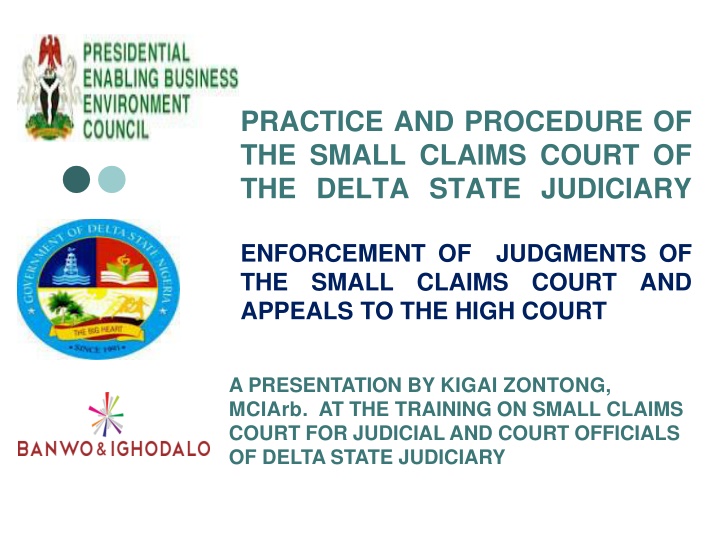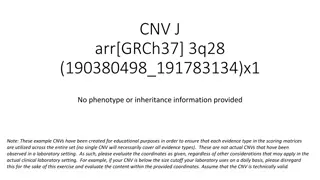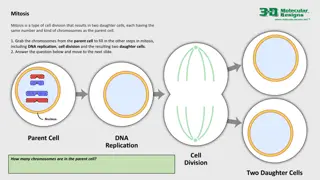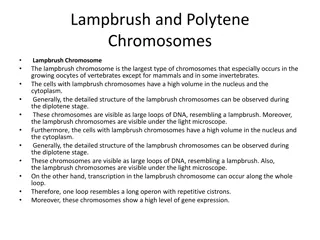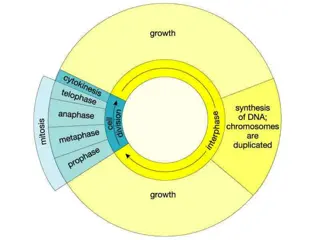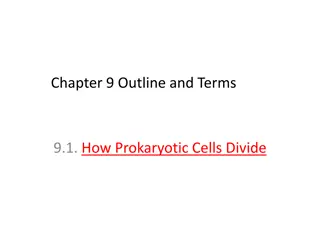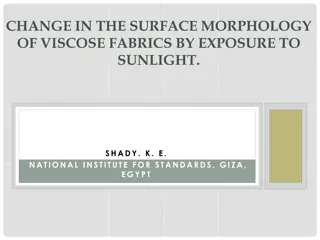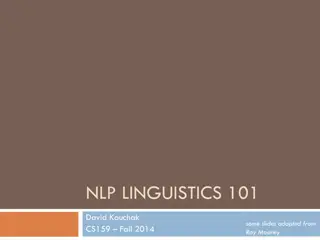Chromosome Morphology and Karyotype Analysis
Chromosome morphology is visualized through techniques such as G-banding, Q-banding, and ISCN human ideogram. Heterochromatic regions with AT-rich DNA stain darkly in G-banding, while gene-rich euchromatin appears as light bands. Karyotyping provides a comprehensive view of an individual's chromosomal makeup, aiding in genetic diagnosis and research.
Download Presentation

Please find below an Image/Link to download the presentation.
The content on the website is provided AS IS for your information and personal use only. It may not be sold, licensed, or shared on other websites without obtaining consent from the author.If you encounter any issues during the download, it is possible that the publisher has removed the file from their server.
You are allowed to download the files provided on this website for personal or commercial use, subject to the condition that they are used lawfully. All files are the property of their respective owners.
The content on the website is provided AS IS for your information and personal use only. It may not be sold, licensed, or shared on other websites without obtaining consent from the author.
E N D
Presentation Transcript
PRACTICE AND PROCEDURE OF THE SMALL CLAIMS COURT OF THE DELTA STATE JUDICIARY ENFORCEMENT OF JUDGMENTS OF THE SMALL CLAIMS APPEALS TO THE HIGH COURT COURT AND A PRESENTATION BY KIGAI ZONTONG, MCIArb. AT THE TRAINING ON SMALLCLAIMS COURT FOR JUDICIAL AND COURT OFFICIALS OF DELTA STATE JUDICIARY
PARTA ENFORCEMENT OF JUDGMENTS OF THE SMALL CLAIMS COURT
Introductory Matters In litigation, a successful party is entitled to the fruit of their judgment in the absence of any legal inhibitions in the form of an order for stay of execution of the judgment or injunction pending appeal. Reaping the fruit of judgment is done by initiating the prerequisite legal process to enforce the judgment. The enforcement of court judgments is regulated by law in order to properly obtain for the successful party, due compensation, restitution, performance or compliance with what the court has granted by way of remedy or relief. Compliance with court orders is not discretionary or optional, court orders must be obeyed in the absence of any legal process to forestall compliance.
Introductory Matters (Contd.) The enforcement of a judgment becomes a necessity where there is partial or no compliance by the unsuccessful party (judgment debtor) with the terms of the judgment when the successful party (judgment creditor) wants to take benefit of the judgment. The nature of the judgment sought to be enforced determines the appropriate mode of enforcement of such judgment. The power of the court to enforce and ensure compliance with its judgment or order is derived from the 1999 Constitution (As Amended). Apart from the Constitution, other laws which regulate the enforcement of judgment are the Sheriffs and Civil Process Act (SCPA), the Judgment (Enforcement) Rules ("JER") made pursuant to the SCPA and the Delta State Practice Direction on Small Claims 2023 ( PracticeDirections ). This presentation discusses the features of judgments and the enforcement procedures at the Magistrate Courts, as well as appeals to the High Court of Delta State.
Meaning of Judgment A court s final determination of the rights and obligations of the parties in a case. It also extends the term to include an equitable decree and any order from which an appeal lies. In A.G. Enugu State v Fairlakes Hotel Ltd (1998) 12 SCNJ (Pt. 1) 1 at 13, the Supreme Court defined judgment as the sentence of law pronounced by the court upon the matter contained in the order. A judgment is the decision and/or findings of the court upon, a consideration of the cases presented by parties to the suit. Judgment creates and vests rights and obligations in the parties, making it obligatory for them to obey it.
Classification of Judgments A declaratory judgment declares or proclaims the existence of a legal relation but contains no specific order to be carried out by or enforced against the defendant. It is a mere declaration of a party s rights with regard to a subject matter. Declaratory A declaratory judgment or order may only be enforced by a subsequent action. JUDGMENTS Does not only declare the rights of the parties but also proceed to direct the unsuccessful party to perform an act namely; to pay damages or refrain from interfering with the successful party s right. Executory An executory judgment or order has coercive force and such order is enforceable by execution if not complied with.
Special Provisions on the Enforcement of Judgments of the Small Claims Court While Section 294(1) of the CFRN (as amended) gives courts up to 90 days after the conclusion of evidence and final addresses to deliver their decisions, Article 12(1) of the Practice Directions provides that the Magistrate of the Small Claims Court shall endeavour to deliver judgments within fourteen (14) days of the completion of hearing. The judgment shall include the Court s determination of issues raised in any interlocutory application(s) filed by any of the parties The entire period of proceedings from filing till judgment shall not exceed sixty (60) days. However, the judgment of the court shall not be invalid proceedings of the court having exceeded sixty (60) days. Article 12 (2) & (3) by reason of the entire The Magistrate shall issue authenticated copies of the judgment immediately after its delivery and not later 7 days from the date of the judgment. (Article 12 (4).
Special Provisions on the Enforcement of Judgments of the Small Claims Court The general rule is that judgment of a court should be complied with without demand, immediately after the judgment has been delivered. However, the judgment itself may direct a period when it is to take effect. In such cases, the judgment will take effect at the specified period. In the Small Claims Court, the unsuccessful party is to comply with the judgment and pay the judgment sum forthwith or as may be ordered by the court. Article Directions. 13(1) of the Practice Upon default of the unsuccessful party to pay the judgment sum within the time specified, the judgment shall be enforced like any order of the Magistrate Court for the payment of money. Article 13(2) of the Practice Directions.
Methods of Enforcement of Judgment Judgment for the Possession of Land Judgment for the Payment of Money Writ of Possession Writ of Sequestration Committal Order Writ of Fieri Facias (Fifa) Garnishee Proceedings Writ of Sequestration Judgment Debtor Summons Types of Judgments and their various Methods of Enforcement Judgment ordering or restraining the doing of an act Judgment for the Possession of Goods Writ of Specific Delivery or Restitution of their value Writ of Sequestration Committal Order Committal Order Writ of Sequestration
Methods of Enforcement of Judgments of the Small Claims Court By the nature of proceedings before the Small Claims Court, the judgment would almost always involve payment of money or delivery Furthermore, Article 13(2) of the Practice Directions provides that the Judgments of the Small Claims Court shall be enforced in like manner as any Order of the Magistrate Court for the payment of money. We shall therefore consider the methods for enforcing money judgments. of goods. Under the Judgment (Enforcement) Rules made pursuant to the SCPA, a judgment for payment of money to a party is enforced by one or more of the following modes: Writ of Fieri Facias (Fifa) Garnishee Proceedings Judgment Summons Writ of Sequestration
Writ of Fieri Facias (Fifa) This is the most prominent of all writs of execution. It is used when the judgment creditor seeks to recover the amount the court ordered to be paid by the judgment debtor. This is done by the seizure and sale of the judgment debtor s goods or chattels wherever they may be found within the state. The judgment debt is then paid from the proceeds of the sale. The writ typically orders the Sheriff to seize and sell enough of the movable properties belonging to the judgment debtor to satisfy the judgment debt. The execution is against goods and chattels and it is where these are not sufficient for payment of the debt that execution is extended to immovable properties.
Garnishee Proceedings Garnishee Proceedings involve the attachment of debt due from a third party to the judgment debtor and the use of the amount in liquidating the judgment debt. The third party indebted to the judgment debtor is called the garnishee. For any money to be attachable, it must be money owed the judgment debtor by the garnishee or money belonging to the judgment debtor but which is in the custody of the garnishee. To this extent, any amount of money standing to the credit of the judgment debtor has been held to be a debt within the meaning of debt owed by another person to the judgment debtor. Such a debt must have been due and accruing to the judgment debtor. It must also be an ascertainable sum and the judgment debtor must have an immediate legal right to it. An insurance policy being an unliquidated claim for money cannot be attached. The third party against whom a garnishee proceeding is to be instituted must be within the jurisdiction of the court . See Section 83(1) SCPA.
Garnishee Proceedings (contd.) Under Article 13 (3) of the Practice Direction, Garnishee Proceedings is ought to be commenced by an application to the court by motion filling and filing Form SCC 9 with accompanying affidavit containing the following: The name and address of the JD; Details of the judgment or order sought to be enforced; The amount of money remaining due under the judgment or order; Amount of any instalment due, if applicable; The name and address of the third party (garnishee); If the JC knows or believes that any person other than the JD has any claim to the money owed by the garnishee, state the name, address and such other information known to the JC about said person; Details of any other applications for third-party debt orders issued by the JC in respect of the same judgment debt. a) b) c) d) e) f) g)
Garnishee Proceedings. If the garnishee is a bank or building society, the affidavit must state; The garnishee s name and branch address where the JD s account is believed to be held; i. The account number, or, if the JC does not know all or part of this information, confirmation that to the best of the JC s knowledge or belief, the garnishee (a) is within the jurisdiction; and (b) owes money to or holds money to the credit of the JD. ii. This provision of Article 13 (3) takes into account the recent decision of the Court of Appeal in Guaranty Trust Bank v. Engr. Bamanga Tafida & Anor. (2021) LPELR-56131(CA) where the court held that the JC does not have a free right of action to proceed against any person or entity without cause he is only entitled to sue a person indebted to the JD.
Garnishee Proceedings (contd.) After hearing the motion ex parte, the court may make an order nisi which is served on the garnishee and the judgment debtor, at least 14 days before the return date. Where a garnishee is served, he can either pay the amount of the debt or dispute it. If he pays the amount, the proceeding becomes terminated. If he disputes the liability to pay the debt, he appears before the court to be examined orally after which the court either discharges him from the order nisi or makes an order absolute.
Judgment Summons This is also known as Judgment Debtor Summons (JDS). By this method, a judgment debtor who is capable of satisfying the judgment debt, but fails to pay the debt may be committed to prison for his default. However, such a consequence is for a debtor who has the means to satisfy the judgment but refuses to so do and not where such default arises out of poverty. The judgment debtor is summoned to court and examined orally on oath in court as to his means and if the court is satisfied of his ability to pay, may commit the judgment debtor to prison for any term not exceeding six weeks or order an attachment and sale of the judgment debtor's property. Section 63 SCPA
Writ of Sequestration Execution of judgment by writ of sequestration is directed against the movable and immovable properties of the judgment debtor, but not with a view to their sale as in the case of writ of fifa. The circumstances under which a writ of sequestration may be issued are: a) Where an order of arrest, commitment, or imprisonment has been issued against a judgment debtor but he cannot be found thereby making the execution of the order or warrant against him impossible; he may have gone into hiding or just disappeared in order to evade or frustrate the execution. b) Where he has been arrested and detained in custody for failing to obey the judgment of the court but in spite of the arrest and detention, persists in his disobedience of that judgment. Section 82 SCPA
In any of these two cases, the court may order the writ to issue against his property. It must be noted that the writ of sequestration against an immovable property can only be issued by a High Court. A Magistrate Court has no power to do so. Order 4 Rule 13 of the JER. If the judgment was given by a Magistrate Court, proceedings subsequent to that judgment must be transferred to the High Court for the issuance of the writ.
PART B APPEALS TO THE HIGH COURT OF DELTA STATE
Appeals An appeal is an invitation to a higher court to review the decision of a lower court to find whether on proper consideration of the facts before it and the applicable law, that court arrived at a correct decision. The right of appeal is statutory. Where no such right is provided for in a statute, no party can appeal. The power of a court to entertain an appeal is equally conferred by statute. No court has an inherent jurisdiction to entertain an appeal. Section 272(2) of the CFRN 1999 (as amended) gives the High Court of Delta State appellate jurisdiction to hear and determine all appeals from the decision of Magistrate Courts in the state. This includes judgments of the Magistrate Courts sitting as Small Claims Court.
Appeals from the Small Claims Court Relevant Provisions o Appeals against the decisions of the Small Claims Court lie to the High Court of the State. o By the provision of Article 14(1) of the Practice Direction, a party who is aggrieved with the decision of the Small Claims Court may appeal to the High Court of Delta State. o Consequently, an aggrieved party must therefore file a Notice of Appeal as in Form SCC 8 within fourteen (14) days of the delivery of the Judgment and the Notice must include the reason(s) for the Appeal. Art. 14(2) o The Officer in charge of the Small Claims Registry shall compile the records of appeal within fourteen (14) days of the submission of Form SCC 8, and the Records of Appeal shall thereafter be forwarded to the Fast-Track Regsitrate of the High Court. Article 14(3) & (4)
Notice of Appeal A party unsatisfied with the judgment of the Small Claims Court shall file a Notice of Appeal in the form prescribed in Form SCC 8. The Notice of Appeal shall include: a) the parts of the decision complained of, b) the ground(s) of appeal, c) the particulars of error in support of the grounds of appeal, d) the reliefs sought from the High Court, e) the names and addresses of the persons affected by the appeal.
Grounds of Appeal Grounds of appeal are allegations of error of law or fact made by an appellant as the defect in the judgment appealed against and on which it is relied upon to set it aside. The essence of a ground of appeal is to apprise the opposite party of the nature of the appellant s complaint clearly and unambiguously. The grounds of an appeal are about the most important aspects of a notice of appeal. Before one can have a notice of appeal, one must have at least one valid ground of appeal.
Hearing of the Appeal The Hearing the earliest convenience of the court.- Article 14 (4) Judge Notices to be issued to the parties and appeal shall be so designated shall cause heard at the The appeal shall be by written briefs of the parties and on the records of the appeal. Parties may however address the court orally as the court may deem fit-Article 14(5) The whole appellate process from the assignment of the appeal to Judgment shall not exceed thirty (30) days.- Article 14(6)
